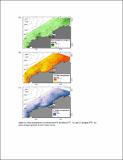Por favor, use este identificador para citar o enlazar a este item:
http://hdl.handle.net/10261/276327COMPARTIR / EXPORTAR:
 SHARE SHARE
 CORE
BASE CORE
BASE
|
|
| Visualizar otros formatos: MARC | Dublin Core | RDF | ORE | MODS | METS | DIDL | DATACITE | |

| Título: | Shifts in the seasonal trophic ecology of larvae and juveniles of European hake (Merluccius merluccius): From the Galician upwelling system (NW Spain) |
Autor: | Laiz-Carrión, Raúl; Cabrero, Águeda; Quintanilla, José María; Hernández de Rojas, Alma CSIC ORCID; Uriarte, Amaya; Gago, Jesús CSIC ORCID; Rodríguez, José María; Piñeiro, Carmen G.; García, Alberto; Saborido-Rey, Fran CSIC ORCID | Palabras clave: | European hake larvae Oceanographic conditions Stable isotope analysis Trophic ecology Isotopic niche width NW Spain |
Fecha de publicación: | 2022 | Editor: | John Wiley & Sons | Citación: | Fisheries Oceanography 31(5): 539-553 (2022) | Resumen: | The trophic ecology of European hake (Merluccius merluccius) larvae and early-juveniles from the Iberian shelf off Galicia (NW Spain) are assessed by means of stable isotopes (SIA) and nutritional condition in conjunction with hydrobiological variations observed during the winter and summer season of 2012. Hake early-juveniles (18–47 mm SL) showed higher δ15N than larvae (3–11 mm SL) together with the microzooplankton (55–200 μm) and mesozooplankton (>200 μm) during both seasons. Low δ15N values and high variability in both zooplankton and hake larvae were found during winter coinciding with an unusually strong upwelling event. Inversely, high δ15N content in zooplankton in summer suggests strong nitrogen reutilization. However, hake larvae sampled in summer had a higher RNA:DNA ratio in line with higher Fulton condition factors than those sampled in winter. Higher δ13C values for microzooplankton and mesozooplankton and hake larvae in summer compared to late winter point to prey availability differences. The relationship between nitrogen and carbon stable isotopes versus size or weight suggests an ontogenetic shift in the diet of hake larvae. Early-juveniles had a lower isotopic niche width compared to larvae in both late winter and summer, indicating a trophic specialization related to changes following settlement process from planktonic life to demersal habitat. Higher trophic specialization was observed in summer, which recorded a narrower isotopic niche and higher trophic position estimations | Descripción: | 15 pages, 8 figures.-- This is an open access article under the terms of the Creative Commons Attribution-NonCommercial-NoDerivs License | Versión del editor: | https://doi.org/10.1111/fog.12603 | URI: | http://hdl.handle.net/10261/276327 | DOI: | 10.1111/fog.12603 | ISSN: | 1054-6006 | E-ISSN: | 1365-2419 |
| Aparece en las colecciones: | (IIM) Artículos (IEO) Artículos |
Ficheros en este ítem:
| Fichero | Descripción | Tamaño | Formato | |
|---|---|---|---|---|
| Shifts_seasonal_OA_2022.pdf | 3,17 MB | Adobe PDF |  Visualizar/Abrir | |
| fog12603-sup-0001-supplementary file.pdf | 480,25 kB | Adobe PDF |  Visualizar/Abrir |
CORE Recommender
SCOPUSTM
Citations
1
checked on 12-abr-2024
WEB OF SCIENCETM
Citations
1
checked on 19-feb-2024
Page view(s)
55
checked on 19-abr-2024
Download(s)
63
checked on 19-abr-2024
Google ScholarTM
Check
Altmetric
Altmetric
Este item está licenciado bajo una Licencia Creative Commons

